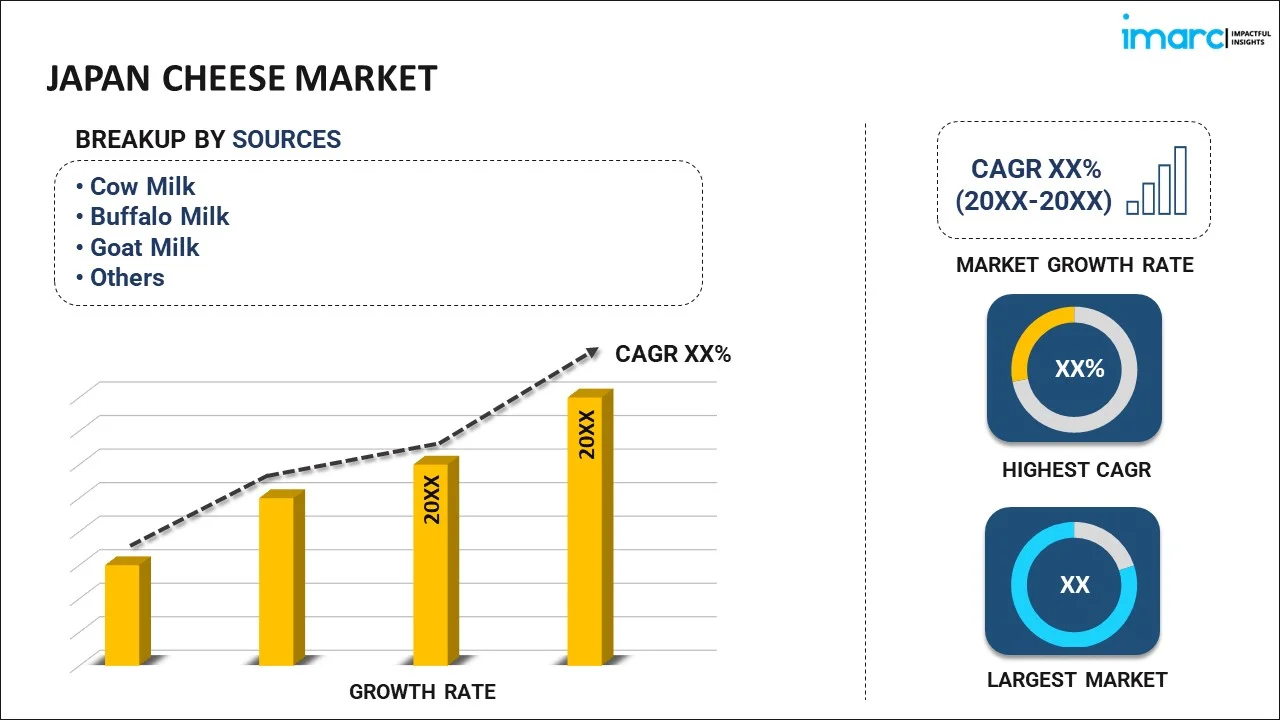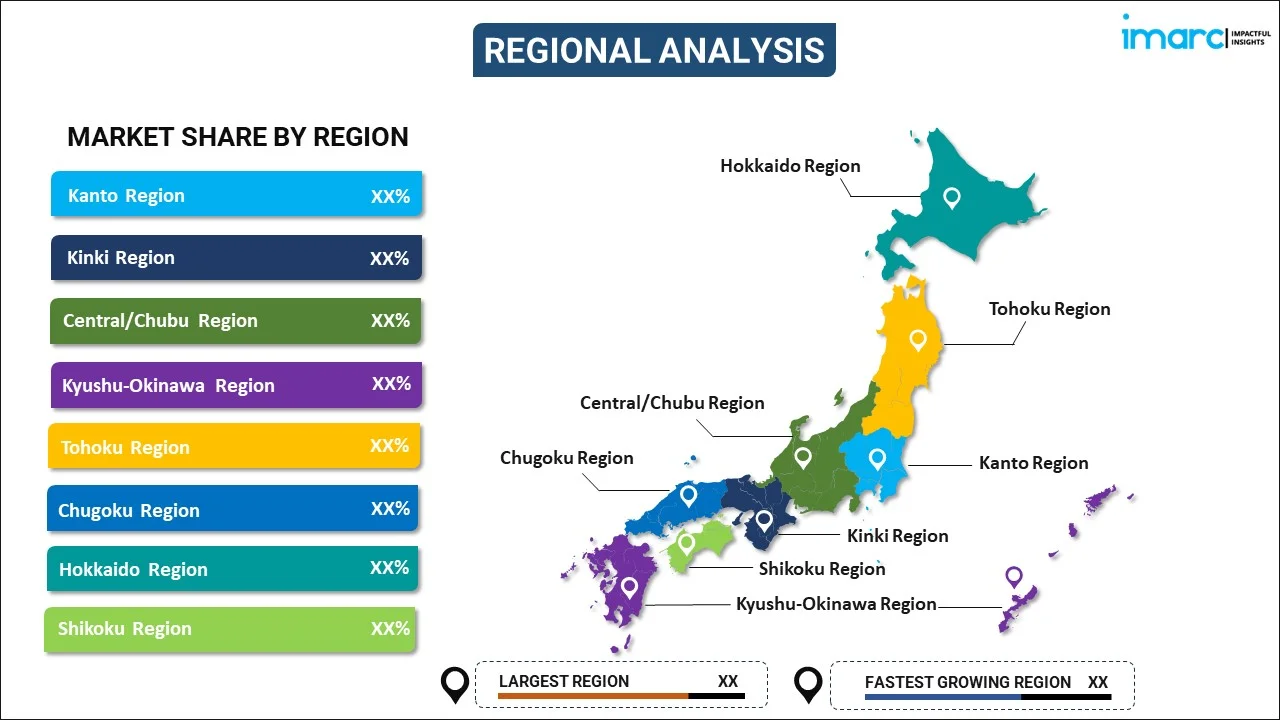
Japan Cheese Market Report by Source (Cow Milk, Buffalo Milk, Goat Milk, and Others), Type (Natural, Processed), Product (Mozzarella, Cheddar, Feta, Parmesan, Roquefort, and Others), Distribution Channel (Supermarkets and Hypermarkets, Convenience Stores, Specialty Stores, Online, and Others), Format (Slices, Diced/Cubes, Shredded, Blocks, Spreads, Liquid, and Others), and Region 2025-2033
Market Overview:
The Japan cheese market size is projected to exhibit a growth rate (CAGR) of 1.80% during 2025-2033. The augmenting product demand in the food and beverage (F&B) industry, increasing adoption of Western cuisine among the Japanese population, mass exposure to diverse culinary traditions due to rapid globalization, and considerable rise in quick-service restaurants (QSRs) and fast-food outlets represent some of the key factors driving the market.
|
Report Attribute
|
Key Statistics
|
|---|---|
|
Base Year
|
2024
|
|
Forecast Years
|
2025-2033
|
|
Historical Years
|
2019-2024
|
| Market Growth Rate 2025-2033 | 1.80% |
Cheese is a versatile dairy product renowned for its variety, flavors, and textures, which largely depends on the source of milk, fermentation process, and aging duration. It is a concentrated form of several key nutrients including protein, fat, calcium, and vitamin B12, which contribute to its dietary significance. Cheese is produced through the coagulation of milk protein, or casein, leading to a separation of the milk into solid curds and liquid whey. These curds are then subjected to heating, cutting, cooking, and finally pressing to remove additional whey, resulting in a cheese curd. The cheese curd can then be matured over varying periods of time to develop a diverse array of flavors and textures. The end product finds broad application in culinary practices around the world, employed both as a standalone food item and a flavor-enhancing ingredient in countless dishes. In Japan, cheese has been increasingly incorporated into traditional and modern cuisines, demonstrating its growing popularity and acceptance within the country.
Japan Cheese Market Trends:
The market in Japan is majorly driven by the augmenting product demand in the food and beverage (F&B) industry. This can be attributed to the increasing adoption of Western cuisine among the Japanese population. In line with this, the active participation of the country in the globalized economy, resulting in mass exposure to diverse culinary traditions and growing appreciation for Western food culture are fueling the market. Moreover, the considerable rise in quick-service restaurants (QSRs) and fast-food outlets that utilize cheese as a primary ingredient in their menus is acting as another growth inducing factor for the market. In addition to this, the growing consumer awareness about the nutritional benefits of cheese, such as high protein and calcium content, is also contributing to the market growth. In addition to this, the burgeoning gourmet culture in Japan is resulting in a paradigm shift towards high-quality, artisanal cheeses, both domestically produced and imported, thereby fueling the product demand. Apart from this, the introduction of eco-friendly and organic cheese varieties due to the accelerating environmental and health consciousness trends among the masses, is fueling the market. Furthermore, the proliferation of e-commerce platforms has made access to a wide variety of local and imported cheeses easier, which is stimulating the market. Some of the other factors contributing to the market include favorable government initiatives to promote dairy consumption, rapid urbanization, and innovative product development and marketing strategies by cheese manufacturers across the country.
Japan Cheese Market Segmentation:
IMARC Group provides an analysis of the key trends in each segment of the Japan cheese market report, along with forecasts at the country level for 2025-2033. Our report has categorized the market based on source, type, product, distribution channel and format.
Source Insights:

- Cow Milk
- Buffalo Milk
- Goat Milk
- Others
The report has provided a detailed breakup and analysis of the market based on the source. This includes cow milk, buffalo milk, goat milk, and others.
Type Insights:
- Natural
- Processed
The report has provided a detailed breakup and analysis of the market based on the type. This includes natural and processed.
Product Insights:
- Mozzarella
- Cheddar
- Feta
- Parmesan
- Roquefort
- Others
The report has provided a detailed breakup and analysis of the market based on the product. This includes mozzarella, cheddar, feta, parmesan, Roquefort and others.
Distribution Channel Insights:
- Supermarkets and Hypermarkets
- Convenience Stores
- Specialty Stores
- Online
- Others
A detailed breakup and analysis of the market based on the distribution channel has also been provided in the report. This includes supermarkets and hypermarkets, convenience stores, specialty stores, online and others.
Format Insights:
- Slices
- Diced/Cubes
- Shredded
- Blocks
- Spreads
- Liquid
- Others
A detailed breakup and analysis of the market based on the format has also been provided in the report. This includes slices, diced/cubes, shredded, blocks, spreads, liquid and others.
Regional Insights:

- Kanto Region
- Kinki Region
- Central/ Chubu Region
- Kyushu-Okinawa Region
- Tohoku Region
- Chugoku Region
- Hokkaido Region
- Shikoku Region
The report has also provided a comprehensive analysis of all the major regional markets, which include Kanto Region, Kinki Region, Central/ Chubu Region, Kyushu-Okinawa Region, Tohoku Region, Chugoku Region, Hokkaido Region, and Shikoku Region.
Competitive Landscape:
The report has also provided a comprehensive analysis of the competitive landscape in the Japan cheese market. Competitive analysis such as market structure, key player positioning, top winning strategies, competitive dashboard, and company evaluation quadrant has been covered in the report. Also, detailed profiles of all major companies have been provided.
Report Coverage:
| Report Features | Details |
|---|---|
| Base Year of the Analysis | 2024 |
| Historical Period | 2019-2024 |
| Forecast Period | 2025-2033 |
| Units | Billion USD |
| Scope of the Report | Exploration of Historical and Forecast Trends, Industry Catalysts and Challenges, Segment-Wise Historical and Predictive Market Assessment:
|
| Sources Covered | Cow Milk, Buffalo Milk, Goat Milk, Others |
| Types Covered | Natural, Processed |
| Products Covered | Mozzarella, Cheddar, Feta, Parmesan, Roquefort, Others |
| Distribution Channels Covered | Supermarkets and Hypermarkets, Convenience Stores, Specialty Stores, Online, Others |
| Formats Covered | Slices, Diced/Cubes, Shredded, Blocks, Spreads, Liquid, Others |
| Regions Covered | Kanto Region, Kinki Region, Central/ Chubu Region, Kyushu-Okinawa Region, Tohoku Region, Chugoku Region, Hokkaido Region, and Shikoku Region |
| Customization Scope | 10% Free Customization |
| Post-Sale Analyst Support | 10-12 Weeks |
| Delivery Format | PDF and Excel through Email (We can also provide the editable version of the report in PPT/Word format on special request) |
Key Questions Answered in This Report:
- How has the Japan cheese market performed so far and how will it perform in the coming years?
- What has been the impact of COVID-19 on the Japan cheese market?
- What is the breakup of the Japan cheese market on the basis of source?
- What is the breakup of the Japan cheese market on the basis of type?
- What is the breakup of the Japan cheese market on the basis of product?
- What is the breakup of the Japan cheese market on the basis of distribution channel?
- What is the breakup of the Japan cheese market on the basis of format?
- What are the various stages in the value chain of the Japan cheese market?
- What are the key driving factors and challenges in the Japan cheese market?
- What is the structure of the Japan cheese market and who are the key players?
- What is the degree of competition in the Japan cheese market?
Key Benefits for Stakeholders:
- IMARC’s report offers a comprehensive quantitative analysis of various market segments, historical and current market trends, market forecasts, and dynamics of the Japan cheese market from 2019-2033.
- The research study provides the latest information on the market drivers, challenges, and opportunities in the Japan cheese market.
- Porter's five forces analysis assist stakeholders in assessing the impact of new entrants, competitive rivalry, supplier power, buyer power, and the threat of substitution. It helps stakeholders to analyze the level of competition within the Japan cheese industry and its attractiveness.
- Competitive landscape allows stakeholders to understand their competitive environment and provides an insight into the current positions of key players in the market.
Need more help?
- Speak to our experienced analysts for insights on the current market scenarios.
- Include additional segments and countries to customize the report as per your requirement.
- Gain an unparalleled competitive advantage in your domain by understanding how to utilize the report and positively impacting your operations and revenue.
- For further assistance, please connect with our analysts.
 Inquire Before Buying
Inquire Before Buying
 Speak to an Analyst
Speak to an Analyst
 Request Brochure
Request Brochure
 Request Customization
Request Customization




.webp)




.webp)












